Hopefully you aren’t sick of my tangzhong bread posts because here’s another one. Tangzhong is a method for making bread created by Yvonne Chen, written in her book “65 Degrees Tangzhong.” It produces bread that is incredibly soft and fluffy and manages to stay soft and fluffy for days.
I’ve been trying to do as many creations as possible with the basic milk loaf. Soon I’ll be paying a visit home and my mom recently checked out the original 65 Degrees Tangzhong book for me and is going to help translate it, which means even more recipes for me to try! I can’t wait. I have a feeling though that the basic milk bread will be my favorite since it seems to be the common recipe I come across when I do a search for tangzhong recipes.
I love baking with matcha so I always try to create a matcha flavored something when I come across a new recipe I like. I thought rather than doing a fully matcha roll, it’d be nice to do a matcha mixed with regular white bread. I originally want to create more of a swirl effect, like I did with my matcha chocolate bread roll, but when I was making my rolls, I rolled them the wrong way. I still had time to change it but decided not to. I was curious as to what it would look like. The result is this striped look.
This bread smelled heavenly when it was baking. The bread came out sweet and soft as usual. I enjoyed the blend of matcha with the regular milk bread. I might experiment with a few more versions to decide which one is best to bring home to my parents when I go visit them in a few weeks.
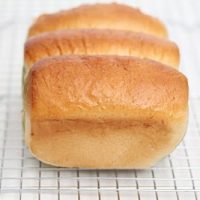
Matcha Milk Bread
Ingredients
- 2½ cups bread flour
- 1/2 tsp salt
- 3 tbsp +2tsp sugar
- 2 tsp instant yeast
- 2 large eggs
- ½ cup skim milk
- 120 gm tangzhong (see note)
- 3 tbsp unsalted butter cut into small pieces and softened at room temperature
- 1 tbsp matcha green tea powder
Instructions
- Combine the flour, salt, sugar and instant yeast in a bowl of a stand mixer. Make a well in the center. Place 1 egg, milk, and tangzhong in the well. Fit the dough hook attachment on your stand mixer and begin mixing on medium speed and knead until your dough comes together and then add in the butter and continue kneading. Keep kneading until the dough is smooth, not too sticky on the surface and elastic. I kneaded the dough for about 18-20 minutes. Each mixer may vary.
- When the dough is ready it should not be very sticky and should be elastic. To test this, you should be able to take a chunk of dough and stretch it to a very thin membrane before it breaks. When it does break, the break should form a near perfect circle.
- Knead the dough into a ball shape with your hands. Split the dough roughly in half. Put half the dough back into the mixer. Add the matcha powder and continue kneading for about 2 minutes on medium speed or until matcha powder is thoroughly mixed into the dough. Grease two large bowls with oil. Place each dough ball into a greased bowl and cover with a wet towel. Let it proof until it’s doubled in size, about 40 minutes.
- Transfer to a clean surface. Divide each dough into four equal portions so you end up with eight pieces. Knead into balls. Cover with cling wrap, let rest for 15 minutes.
- Roll out each portion of the dough with a rolling pin into an oval shape. Take one piece of matcha dough rolled out into an oval and put it on top of the white dough already rolled out into an oval. Run the rolling pin a few times on top so that the two doughs begin to stick together to be one piece of dough. Take one end of the dough and fold to meet the middle of the oval. Take the other end and fold to meet on top.
- Flip dough over with the folds facing down, and flatten dough with rolling pin.
- Flip dough over so the folds face up. Now roll the dough up. Place each of the rolls into the bread pan and put a piece of plastic wrap over the rolls. Let them rise until double the size, approximately another 40 minutes
- In a small bowl, beat 1 egg and brush egg mixture on top of the loaf to create shiny eggwash finish.
- Bake at 325°F for approximately 30 minutes.
Notes
Nutrition
The nutrition information provided are only estimates based on an online nutritional calculator. I am not a certified nutritionist. Please consult a professional nutritionist or doctor for accurate information and any dietary restrictions and concerns you may have.

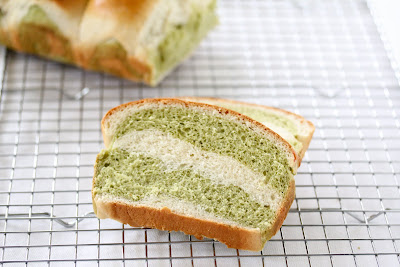


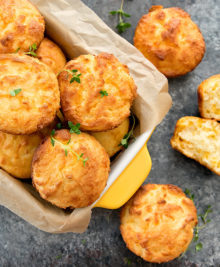
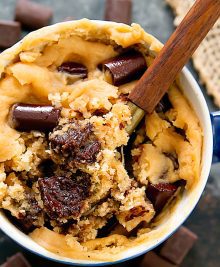
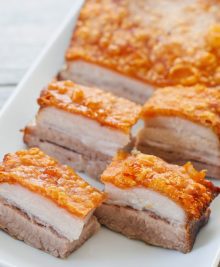

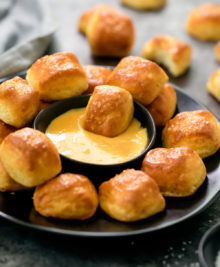
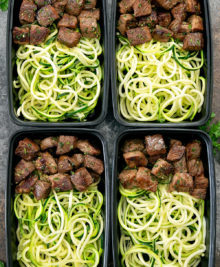
I tried this recipe for my first trial in bread making. It was awesome having the aroma of bread filling my kitchen . Thank you.
I’m so glad it worked out for you!
I just tried your recipe for the first time, but I had to do some adaptation because my yeast is a paste (my own culture that I maintain) It still ended up a little to liquid and after 40 minutes of kneading still would not form a ball or become roll-able, so I just dumped it into a cake pan and baked it at 200c for 40 minutes. It turned out amazing, a cake – bread high-bread (pun intended). Really nice. I will be making this pretty often I think. Thanks!
so glad you got it to work!
Hi there! I made this and the swirl was absolutely gorgeous! I was a bit sad though that the bread didn’t develop the matcha taste I was expecting. I reckon it had more to do with my matcha powder, but next time I’m trying this with more matcha, and perhaps divide the dough into three and add a cocoa swirl. So excited to talk about my own experience with this bread on my blog. Thanks for sharing! 🙂
I recommend a good quality matcha powder. I usually use Maeda-En (the gold canister quality)
Hey, i’m interested in making this bread, but is the matcha taste strong? Can you distinctly taste the green tea in the bread?
yes the matcha taste is strong, especially if you use a high quality matcha powder
Thank you for the recipe! I tried and the bread turned out delicious. Finally found a recipe for light and fluffy bread 😀
So glad you enjoy it! I love this bread technique
Hello there! Just curious, can I bake a whole loaf of this bread from my bread machine? In other words, will the bread come out with the same texture and fluffiness if I just dump all the ingredients in the bread machine and let it mix/knead/bake? Thanks!
Sorry, I don’t know the answer to that. I haven’t tried it. But I’m guessing it will not be the same because of all the different steps that are needed in this recipe.
Oh — and I forgot to mention, that the top of the bread was perfect and completely cooked. Any more time in the oven, and that section would’ve likely been overcooked.
Hi! Just found this recipe and made it last night. The bread was delicious, but I did have one problem. It tasted quite dough-y, if that makes any sense. Is the loaf supposed to really burst out from the top of the breadpan? I let the dough proof in the breadpan for 40 minutes, but maybe that was too long under my circumstances?
Anyway, it isn’t anything some extra time in the toaster oven couldn’t cure to make it really delicious. But any tips would be nice. I found various solutions elsewhere on the Internet, but wondering if perhaps there is something special having to do with this tangzhong bread.
I’m a total beginner at making bread, by the way. Thanks for the great recipe!
Hmm, I don’t think proofing a little too long should be a problem. My bread usually does sort of burst out from the breadpan too. I would suggest that it just needs more baking time. If the top of the bread is already cooked, then I would lower your oven rack so that the top of the bread isn’t so close to the top of the stove and also tent the top with foil. This will keep the top from overbaking while letting the rest of your bread cook inside. Sometimes I feel like the top of my bread gets overcooked while I wait for the inside to cook, so I will tent the top with foil.
Also did you use the entire tangzhong? Because 120g is only a little over half of what the original tangzhong recipe makes. One fnal thought is that once I tried making the bread with all purpose rather than bread flour and I ended up with a really tasty bread but it tasted doughy too.
Am so happy I stumbled upon your blog – I’ve been wanting to make this type of bread for a while and finally decided to dive in. Your recipe and instructions were perfect!! Was hoping to get your advice on one thing though – for some reason my bread did not rise too much, is there anything I can do to make it more loaf looking? I added red bean paste and rolled it like a swiss roll vs. 3 mini rolls.
Hmm, I’m not quite sure. Perhaps you could let the bread rise longer before you bake it. Did you let it sit again after you rolled it into the swiss roll? Also a warm place really helps the bread rise. I sometimes will leave it near the oven or somewhere really warm.
Thank you, Kirbie. Pity, there is no translation. I’d like to dig into the tangzhong a little, finding out about the scientific aspects and history of it.
Today, I am trying to bake your raisin bread, struggling a little with the measures (here in Germany, we like it easy: measuring everything in grams) and the fact that I want to make the dough without the egg. Well, we’ll see how it’ll come out…
There are tangzhong recipes out there where you can find measurements in grams. I used cups since most of my readers are in the US. I think you can find some research on tangzhong if you google it though. I remember reading some blogs in English about it.
I’d love to read more about your journey with tangzhong. Have you given up on baking with it?
Have been trying to find books about it (can’t read Chinese/Japanese though) to learn more about the backgrounds, but did not find any English oder German literature. Maybe you could name your files?
Love to flip through your pictures – jummy!
I have not given up baking with it; I just haven’t tried any new recipes in a while. But I continue to use it to make bread and am always pleased with the results. The method comes from a book a chinese book written by Yvonne Chen “65 Degrees Tangzhong.” I don’t believe it has been translated into English though. If you google tangzhong, some websites explain the science behind it. Since her book there have been many other new methods using starters as well. I’m going to try some of them and see how they compare to the tangzhong method.
Your bread looks really professionally done!
I’ve been trying the tang zhong method.. And it’s been twice so far, but both times my dough is wet and runny… Despite leading for quite a while with the food processor… It can’t seem to turn out into a dough that can easily be shaped… After baking it is still soft and fluffy but it’s very hard to handle and impossible to shape into buns…
Do advice on how it can be done please…
Thank you…
Hmm, it’s hard to know what someone is doing wrong when I’m not there to observe. I would recommend maybe adding a little more flour if your dough is wet and runny. And also are you using the right amount of Tangzhong? the recipe for the tangzhong actually makes twice the amount needed for the bread. So if you are adding the entire amount of tangzhong your bread will be too wet. You may also want to check your other wet ingredient measurements. When you knead the dough with your food processor, are you using a bread hook attachment? I found that makes a huge difference too. Good luck!
Hi there, first of all, the bread looks divine.
Me and my roommates have a ton of matcha powder that we don’t know what to do with, so we’re going to be trying this out. I was just wondering if the recipe for tangzhong that you linked to yields 120g ? We don’t have a scale or anything so we can’t really measure it out. Thanks!
No the recipe for the tangzhong is more than 120g. It’s about double, so you want to use half.
This looks so nice.Can I use the bread machine to knead the dough? Thanks you
Yes you can also use a bread machine to knead the dough.
Who could ever get sick of soft, fluffy bread recipes? I will have to try this, it looks delicious.:)
absolutely delicious bread! I love super soft and fluffy bread, they are amazing!
This looks so soft and fluffy. I love anything with matcha.
Me too!
Omgosh that looks great! 🙂 Have you tried tangzhong with cinnamon buns yet? I have problems with the dough being tough when I make cinnamon buns so I will try it with this basic dough. Do you think it would work? Wonderful site by the way. 🙂
I have not personally tried it yet, but I’ve seen other bloggers use this tangzhong method in all sorts of bread recipes that don’t usually use tangzhong with great results. I hope it works for you! And I’ve used tangzhong for other sweet pastry breads before with good results so I think it should work with the cinnamon buns. Maybe I will try making them sometime soon.
Wow, these look awesome! I love matcha too(;
Matcha is pretty awesome. I love how it looks, tastes, and that it is good for you.
A lovely colored bread!
iza:)
Thank you!
Beautiful bread and looks so delicious! I love the duo colors, it’s enticing!
Thanks! I love working with green